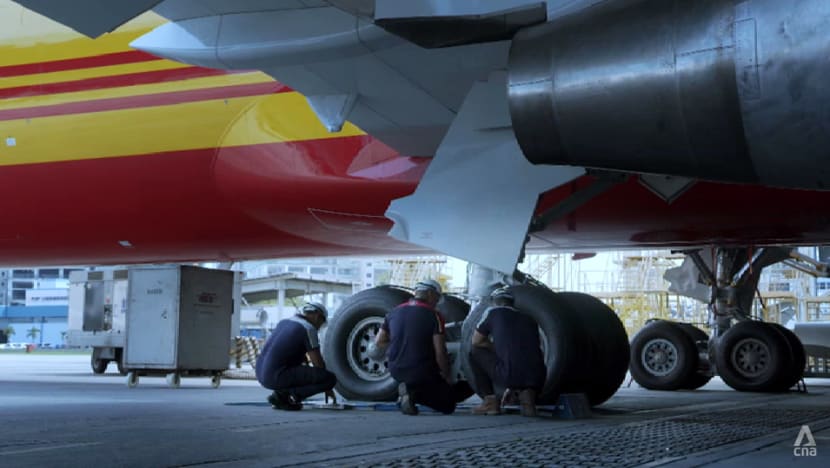Singapore's aviation sector takes off to meet demand, but labour shortage could stall growth
The industry is stepping up efforts to hire more skilled engineers and expanding its facilities, amid greater global appetite for air transport.

Singapore contributes to about 10 per cent of current global MRO output, making it a leading hub in Asia.

This audio is generated by an AI tool.
SINGAPORE: Singapore's aviation maintenance, repair and overhaul (MRO) sector is set for a lift, with more facilities coming onboard.
With greater global appetite for air transport – the United Nations’ aviation agency expects a yearly increase of 4.3 per cent over the next two decades – the demand for MRO is expected to soar.
"There's a long queue for airlines awaiting delivery of new aircraft that they have on order," said Mr Sia Kheng Yok, CEO of the Association of Aerospace Industries (Singapore).
"As such, some of the older aircraft – their service will have to be extended. Hence, more maintenance is needed to ensure that these aircraft remain in very good condition."
MORE FACILITIES
Bellwethers like ST Engineering are looking to do more to meet the demand, such as building additional airframe maintenance hangers in Singapore and abroad.
"We plan to open a new engine shop later this year so that we have more capacity for engine overhaul," said Mr Jeffrey Lam, president of commercial aerospace at ST Engineering.
The facility will provide MRO services for the LEAP-1A and LEAP-1B engines that power narrow-body aircraft, including the new generation Boeing 737 and the Airbus A320. It is expected to provide 200 engine shop visit capacity annually.
The company said these additions will boost its man-hours in Singapore by a third next year – to over 4 million annually.
"We're hiring more people – in Singapore in particular – so that we can grow the amount of services that we can offer to our global customers," Mr Lam said.
The firm wants to add up to 500 staff to its headcount in the next one to two years, with engineer and technician roles certified in avionics and landing gear among the skill demands, added Mr Lam.
STRONG AVIATION SECTOR
Singapore contributes about 10 per cent of current global MRO output, making it a leading hub in Asia.
Industry players believe the nation is well-positioned to leverage the growth.
“For a small country like Singapore, 10 per cent of global market share is very significant,” said Mr Sia, pointing out the aviation sector has recovered well since the COVID-19 pandemic.
Between 2022 and 2024, Singapore bagged over S$750 million in investment commitments from aerospace companies.
Last year, Changi Airport handled almost 68 million passengers, which is 99 per cent of pre-pandemic levels. National carrier Singapore Airlines (SIA) and its low-cost arm Scoot flew 39 million passengers the same year, 12.7 per cent more than in 2023.
“Singapore has historically been able to attract very high-quality aviation and MRO players to base their facilities here,” said Mr Joshua Ng, director of Alton Aviation Consultancy.
“We think that Singapore is one of the few countries that are poised to tap on this growing demand in the MRO sector.”
MANPOWER SHORTAGE
However, industry players said ongoing manpower constraints could ground growth.
“MRO capacity is quite limited, and at the same time, the supply chain is highly constrained and talent is in short supply,” said Mr Sia.
“Fortunately, during the pandemic, we were able to maintain a good proportion of our workforce, which allowed us to ramp up to capture the surge in demand.”
He added that challenges remain in ensuring that enough people can access opportunities in aerospace, as well as in upskilling and cross-skilling the existing workforce.
Currently, efforts to build a talent pipeline include partnerships with educational institutes and career fairs.
ROLE OF AI IN MRO
Market watchers said artificial intelligence could help to address the staffing shortages by helping mechanics and engineers with routine and tedious work.
AI is driving transformation in the sector, allowing jobs to evolve to provide higher value products and services.
“In the past, repairs will only be done when defects are found. (AI will make the process) more proactive and more service oriented… leveraging data to predict whether maintenance (should) happen,” said Mr Ng.
AI makes it possible to predict failures before they occur, by monitoring performance data and identifying patterns of degradation, to avoid situations where planes cannot fly due to faulty parts, he added.
“The role of the human now will be more in terms of sense-making, interpreting the data… doing final quality checks, repairs and sign-offs to make sure that everything is in order for the aircraft to fly,” he explained.
With Terminal 5 on the horizon, Mr Ng said Singapore's MRO sector is ready to reach new altitudes, cementing its status as a global air hub.















